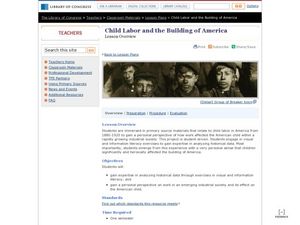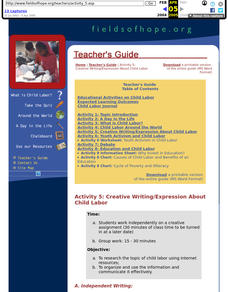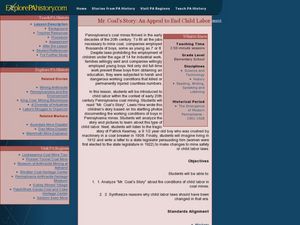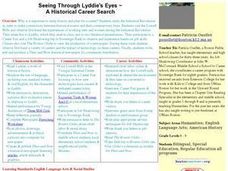Library of Congress
Child Labor in America
Students investigate child labor during the Great Depression. In this US policy lesson, students evaluate multiple layers of the social, economic, and political affects of policy during the Great Depression. Students will engage in 5...
Curated OER
Childhood Lost: Child Labor in the United States, 1830-1930
Working in groups, middle and high schoolers describe and discuss photographs depicting working conditions experienced by child laborers in the 19th century. They then write a persuasive paragraph supporting an amendment to regulate the...
Alabama Department of Archives and History
A Lifetime of Responsibilities: Child Labor in Alabama
Imagine children working long hours in factories, coal mines, and in the fields. Class members examine a series of pictures and read about early attempts to regulate child labor and current child labor laws.
Curated OER
Child Labor during the Industrial Revolution and Now
Fifth graders research topic of child labor by studying Industrial Revolution, read about child labor laws, and examine countries where child labor still exists today. They then choose single question to research from list, and create...
Curated OER
Child Labor in the Carolinas
Fifth graders explore child labor and how children were exploited and used in the work place. For this Industrial Revolution lesson, 5th graders research child labor by reading, looking at photographs and drawing conclusions then sharing...
Syracuse University
American Industrial Revolution
While the Industrial Revolution may have fueled America's rise to the top of world markets, the child laborers often faced dangerous conditions. Using primary source images and other information, scholars consider what these children...
Curated OER
Child Labor and the Building of America
Students analyze the growth of America from the 1880's-1920's. In this Industrialization era instructional activity, students use primary resources from the time period to investigate child labor, and determine the contribution of...
Curated OER
Child Labor in America
Learners interpret historical evidence presented in primary and secondary sources. In this child labor instructional activity, students examine the issue of child labor and determine how citizen...
Curated OER
Child Labor Laws in the United States and the State of Nebraska
Students examine child labor laws. In this social justice activity, students compare and contrast child labor laws of the United States and the state of Nebraska. Students research primary sources and complete the included analysis...
Curated OER
Activity 5: Creative Writing/Expression About Child Labor
Students research child labor using Internet resources. They present the information in a creative writing piece and post it on Chalkboard.
Curated OER
Child Labor Laws in America and Nebraska
Students research child labor laws in Nebraska and America. In this child labor lesson, students examine primary and secondary sources regarding legislation on child labor and create posters that highlight the laws of 1907 and 1910.
Curated OER
Mr. Coal's Story: An Appeal to End Child Labor
Pupils read about child labor in the early 20th century. In this Pennsylvania history activity, students read a story about child labor and discuss reasons why child labor laws should have existed during the early 20th century.
Roy Rosenzweig Center for History and New Media
Labor Unions in an Industrializing U.S.
Have class members eager to enter the workforce? They'll be glad to learn that things aren't how they used to be. Have your young historians examine then discuss four primary source images related to the negative effects of...
Center for History Education
Methods of Reform: The Lowell Mill Girls
Although the girls and women who worked in the Lowell Mills are not often seen this way, they are the forbearers of the American labor movement. Pupils examine primary sources, including testimony about life at Lowell and labor laws, as...
Curated OER
History of American Child Labor
Students study the historical and social issue of child labor. They examine the photographs of Lewis Hine to see evidence of child labor and decide how the photographs depict the historical impact of the practice. They write a letter to...
Curated OER
Photographs of Lewis Hine: Documentation of Child Labor
Young scholars use the Archival Research Catalog to complete assignments and activities about Lewis Hines and the National Child Labor Committee.
Curated OER
Early Industrialization
Eighth graders analyze primary source documents emphasizing young people in factory labor (mill workers during 1840-1860). They study hours of labor, ages of laborers, reasons for working, and working conditions. They write a poem or song.
Curated OER
Child Labor Slide Show
Young scholars review ideas shared about the American worker while reading poems of Carl Sandburg. They now view a slide show of what they looked like. While students view the slide show, the teacher goes over information. A link is...
Center for History Education
The Triangle Shirtwaist Factory Fire: Is Anyone to be Punished for This?
The stories of bodies falling to the pavement and girls dying in their seats echo to the present day. The New York City Triangle Shirtwaist Factory fire—which killed 147 people, mostly young women and girls—galvanized the labor movement...
National Woman's History Museum
The Triangle Shirtwaist Fire
On March 25, 1911, 146 garment workers died in the Triangle Shirtwaist Factory fire. Class members use primary source documents to research the tragedy and how it lead to the creation of labor unions and new labor laws. As an exit...
Curated OER
Child Labor
Students examine how how groups and institutions work to meet individual needs and promote the common good, and identify examples of where they fail to do so. They describe how workers with specialized jobs and the ways in which they...
Curated OER
A Historical Career Search
Learners analyze the use of language, including non-standard written and oral English. They write persuasive, descriptive, narrative and/or evaluative pieces in response to the story read and keep reflection journals. Finally, students...
Curated OER
The Industrial Revolution
Students explore what life was like during the Industrial Revolution. In this United States History lesson, students analyze a specific job then complete a webquest about that job. Once their research is complete, students work in...
Curated OER
The Most Dangerous Woman in America: Mary Harris "Mother" Jones
Students discover labor issues of the 1800's. For this Pennsylvanian history lesson, students research the case of Mary Harris Jones and discover her work as a labor activist. Students discuss the case together in class.
Other popular searches
- Child Labor 1900s
- Child Labor Laws
- 19th Century Child Labor
- American Child Labor
- Child Labor in India
- Art and Child Labor
- Child Labor Modern
- Child Labor Lesson Plans
- Child Labor in Brazil
- Child Labor Laws Usa
- Child Labor Laws 1900s
- Facts Child Labor 1900s

























